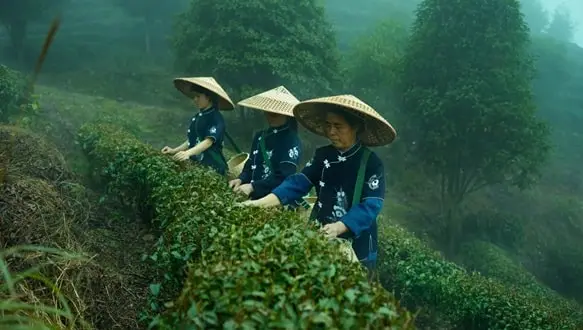From its origination in China in 2737 BC, tea has always been a drink of high demand. In fact the very fabric of global culture is now woven around the custom of drinking tea. On one hand there are the ceremonies in Asian countries, where tea is a staple drink, to the western evening rituals where tea is consumed with light snacks, the legacy of this special drink carries on. Obviously, to cope up with the large demand of tea, a number of companies have been engaged in producing high quality and varied flavored tea in good quantity. Here we will be talking about the top 10 of them and their contributions in the market.
1. China – The Undisputed Tea Pioneer:
China, the origin of tea, produces most tea globally. Its 5,000-year tea heritage combines with its tea cultivation. From Zhejiang’s misty hills to Fujian’s antique tea farms and Yunnan’s huge landscapes, China produces green, black, and oolong teas. China dominates the tea market with its magnificent history and creativity. China produces 68% of the world’s tea, or 2 million tons, giving it its spiritual home. China dominates this tea symphony with Yunnan, Guangdong, and Zhejiang. Most cups of Chinese tea follow centuries-old customs. Zhejiang grows longjing tea, a popular green tea, because to its gorgeous scenery and good climate. Fujian’s tea trade history is shown by Tie Guan Yin oolong tea. The complexity of Chinese teas, notably Yunnan’s distinct tea traditions, maintains China’s global tea market dominance. Cultural tradition, cultivation expertise, and quality dedication define China’s tea production. From the lush slopes of renowned locations to the world’s love of Chinese tea traditions, China’s standing as the world’s leading tea producer is a testament to its tea producing abilities.
2. India – A Mosaic of Tea Cultivation:
India’s enormous Darjeeling and Assam highlands farms produce the second-most tea. The nation is recognised for Assam, Darjeeling, and Nilgiri teas. India began cultivating tea in 1830 and became the world’s second-largest producer, generating 1,208,780 million tons. Darjeeling, Nilgiri, and Assam produce tea. Assam teas are known globally for their strength and taste. With its mist-covered hills, Darjeeling produces delicate, subtle teas, while Nilgiri flavours the nation’s tea tapestry. The tea industry employs millions of Indians and fuels the economy. India is a big tea exporter, supplying nations worldwide. This economic impact highlights India’s tea industry’s importance in global trade.
Also See: Largest Producer Of Silk In The World
3. Kenya – The African Tea Powerhouse:
East African Kenya produces third-most tea. Kericho and Nandi Hills produce robust, brisk teas famous globally. Tea exports from Kenya’s CTC (crush, tear, curl) processing method provide jobs and revenue. Despite Asian dominance, Kenya produces 436,000 tons of tea annually. Kenyan black tea is produced largely in Kericho, Nyambene Hills, and Nandi. Malcolm Bell commercialised Kenyan tea in 1924 after GWL Caine started cultivating it in 1903. Brooke Bond tasked Bell with building Kenya’s tea industry. Crushing, shredding, and curling Kenyan CTC tea leaves creates small, potent pellets with a strong, stimulating taste. This unique process has boosted Kenya’s reputation for high-quality black tea and made Kenyan tea a sought-after beverage globally.
4. Sri Lanka – The Jewel in the Tea Crown:
Nuwara Eliya and Dimbula are prominent tea farms in Sri Lanka, previously Ceylon, the fourth-largest tea grower. The global tea industry benefits from Ceylon’s high-quality tea. The global tea market respects Ceylon tea for its distinct tastes. Sri Lanka produces 18% of the world’s tea, or 340,200 tons. Uva and Kenilworth thrive in Sri Lanka’s central highlands, where tea is grown. Sri Lanka, created by the British in 1867 to challenge China’s tea monopoly, provides world-class single-origin teas. This tea legacy raises Sri Lanka’s GDP by 2% and solidifies its tea leadership.
5. Turkey – Bridging Continents with Turkish Tea:
At the crossroads of Europe and Asia, Turkey is a unique tea producer with a rich legacy. Turkish tea is popular in cafes and households. Turkey, the fifth-largest tea producer, produces robust and stimulating black tea from its lush Black Sea coast estates. Our next Middle Eastern trip is Turkey, on historic East-West trade routes. Today, Turkey produces 227,400 tons of tea. Turkish tea culture’s distinctive tea is produced at Rize on the northeast Black Sea coast. More than 60% of Turkey’s tea comes here. Turkish tea’s complicated tapestry includes Trabzon, Giresun, and Ordu.
6. Vietnam – Rising Star in the Tea Realm:
Vietnam is the world’s sixth-largest tea producer due to Thai Nguyen and Lam Dong’s growth. Vietnamese green teas are refreshing and vibrant. Its tea exports have increased, strengthening its global tea market supremacy. We return to Asia and visit Vietnam, where the French introduced tea. Vietnam is a major tea producer, producing 214,300 tons. Green, black, and white teas thrive in Yen Bai, North Vietnam. Black, green, and floral teas like lotus tea are best from Vietnam. The Central Highlands of Thai Nguyen and Phu Tho grow most Vietnamese tea. These places helped Vietnam dominate tea. Vietnam’s large tea portfolio and quality commitment have enabled the tea business grow swiftly and fulfil local and worldwide demand, making it a key participant in tea production.
7. Iran – Persian Elegance in Tea Production:
The tea-consuming Iran ranks ninth in tea output. Iranians cherish tea and have complex tea rituals. Iranian tea, particularly from Gilan and Mazandaran, is famous internationally. Iran, an unusual but important Middle Eastern tea grower, is our destination. Iran produces little over 160,000 tons of tea in Gilan, an unexpected but substantial position in the international tea market. Tea became popular in Iran in the 15th century because to Silk Road trade. Tea was initially utilised in the 15th century, although Iran did not cultivate it until 1899. Prince Mohammad Mirza brought Indian tea bushes to Lahijan. The first modern tea factory built in 1934, marking Iran’s tea production milestone.
8. Indonesia – A Tapestry of Tea Diversity:
Indonesia produces seventh most tea owing to its wide archipelago. In West Java and North Sumatra, Indonesia’s varied tea industry produces black and green teas. Indonesia grows and exports tea, influencing the world tea business. We cross the Indian Ocean to Indonesia, where tea production is barely 150,000 tons. In 1782, the Dutch East India Company brought tea to Indonesia. Wonosari, East Java, produces black and green Assam teas. Indonesian tea growing relies on these climate-adapted varieties over Chinese ones.
9. Argentina – South American Tea Delight:
Argentina contributes mate to the global tea landscape. Misiones and Corrientes produce most tea from yerba mate. Top tea manufacturers include Argentina due of its unique South American teas. We surprise ourselves in Argentina, which produces just 105,000 tons of tea. Indian-hybrid black and green teas are remarkable. Argentina adopted Indian tea traditions in the 1920s as the government encouraged agricultural diversification. Tea growing in Misiones, Corrientes, Formosa, Chaco, and Tucuman transformed Argentina’s agriculture.
10. Japan – The Epitome of Tea Elegance:
Japan’s exquisite green teas and elaborate tea ceremonies end the list. Chanoyu-based Japanese tea culture emphasises simplicity and elegance. Due to Uji and Shizuoka, Japanese tea output ranks tenth globally. Japanese green teas are outstanding because to their distinct tastes and health benefits. Most of Japan’s 84,800 tons of tea, mainly Green Sencha and Green Matcha, is consumed domestically. Buddhist monks introduced tea to Japan in the 6th century for religious rituals. Between 805 and 806 the 52nd Emperor Saga imported additional tea seedlings, shaping Japanese tea history. After these seeds grew, Japan’s tea story started.
Conclusion:
The vibrant market of tea production is gradually expending globally. The production quality has come up a long way from its inception. So, it is important to keep in mind that for the tea drinkers, flavor happens to be very important criteria. The tea leaves of India is quite famous for it. In other countries, tea leaves vary a lot in taste.

Brandon is the cheif editor and writer at WorldUnfolds.com. With a passion for storytelling and a keen editorial eye, he crafts engaging content that captivates and enlightens readers worldwide.















